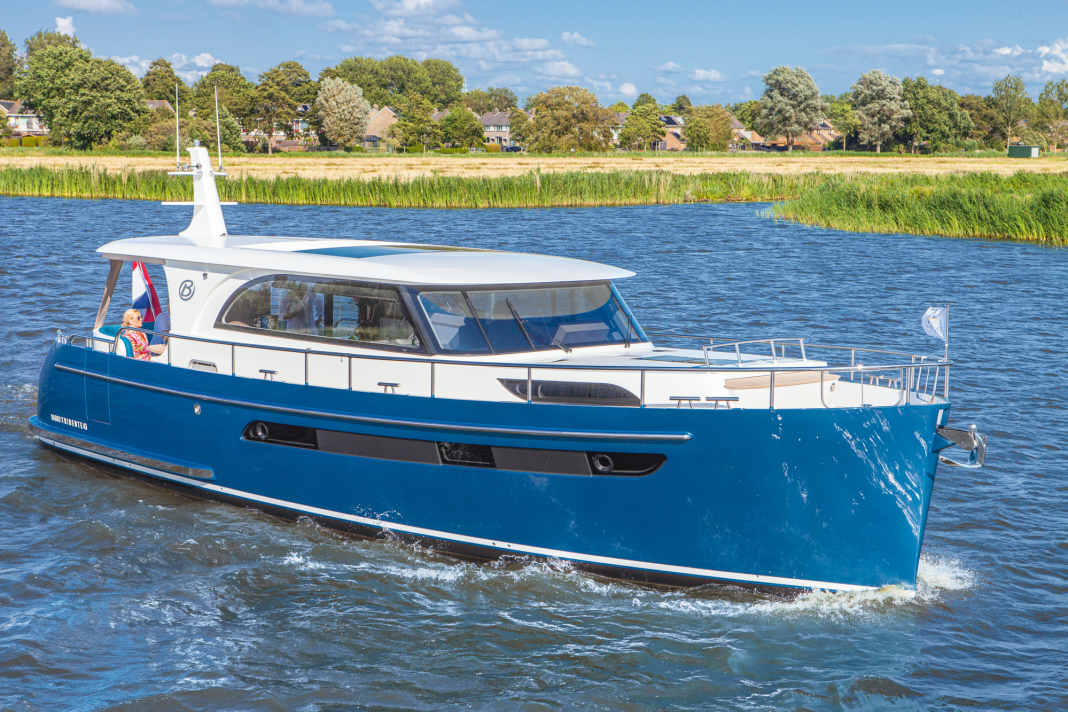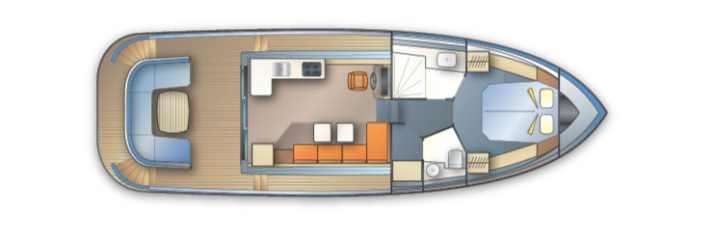





Steel boats often have the suffix AC (Aft Cabin) or OC (Open Cockpit) in their designation. OC usually stands for flat boats with a low clearance height. Our test boat, the Babro Tridente 43 OC, also bears this abbreviation. It has a clearance height of around 2.85 metres and is therefore well suited for inland waterways. A practical sliding hatch is integrated into the steel roof, which allows plenty of fresh air and sunshine into the saloon when open. If you then open the large stern door, the cockpit and saloon become one huge living space. There is a cosy seating area in the saloon and a well-equipped galley on the port side. In the cockpit, the designer has fitted a U-shaped bench seat with a large table. This seating area is also covered by the steel roof, and the sides and stern can be closed off with foil windows so that the travelling companions are completely sheltered. From the cockpit, there are accesses to the side decks, from where you can reach the bathing platform (with a comfortable bathing ladder) via hedge entrances or directly onto the jetty via doors in the side walls. The two side decks naturally also lead to the foredeck, where a solid railing with an oval handrail provides the necessary support. On the foredeck there is an anchor locker with anchor gear, a winch and a bow bench. Plus: everything comes as standard.
The Babro is available in different cabin versions. We sailed the version with two cabins: The owner sleeps in the elegant bow cabin with double berth and the guests in two single berths (can be joined with an upholstered insert) in the underfloor cabin. Both rooms offer good ventilation and storage options. The shower and marine toilet are located in separate rooms, both of which are accessible from the vestibule of the cabins. There is also direct access to the shower room with washbasin and shower cubicle (with large door) from the forward cabin. The room opposite is equipped with a marine toilet, suitable storage and ventilation facilities and a washbasin.
How the Babro Tridente 43 OC moves on the water
The Babro is driven from a well-divided driving position in the saloon. On our test boat, the driver sits on a kind of pilot's seat that can be adjusted in all directions. The rudder and electronic gearstick (Volvo Penta) can be reached without restriction from the driver's seat and both monitors are easy to read. Standard bow and stern thrusters make mooring and casting off manoeuvres easier. The shipyard recommends a cruising speed of around 2100 rpm, which gives us a speed of just under 7 knots and, with a fuel consumption of 1.78 l/sm, a range of 383 nm is calculated with the 800-litre tank minus 15% reserve, which is a good value. The same applies to the noise level of 60 dB/A. We reached around 8.4 knots at full throttle on the Sneekermeer, I put the rudder all the way to the stop and the test boat only leaned slightly to the outside of the bend and travelled smoothly in circles. Propulsion is provided by a 150 hp Volvo Penta with reversing gear. The engine is located under the saloon floor and is accessible via the large stowage box under the cockpit floor (clearance height approx. 0.90 m). The installations and work are not only neatly executed in this area, but throughout the entire boat.
Measurement results

Conclusion
The Babro Tridente 43 OC is a comfortable cruising boat for four people. It has a light-flooded saloon with a well-equipped galley. The workmanship and installations are of a high standard.
Advantages
- + Extensive standard equipment
- + Easy manoeuvring with bow and stern thruster
- + Good range and smooth driving behaviour
Technical data

- Shipyard: Babro Yachting/Netherlands
- Type: Tridente 43 OC
- CE category: B
- Length over everything: 13,00 m
- Width: 4,60 m
- Depth: 1,20 m
- Clearance height: approx. 2.85 m
- Displacement: 20,5 t
- Fuel tank: approx. 800 litres
- Water tank: approx. 600 litres
- Holding tank: 200 l
- Cabins: 2 + Salon
- Berth dimensions: Forward cabin 2.12 x 1.70 m, centre cabin 2x 2.10 m x 0.75 m
- Standing heights: Forward cabin 2.10 m entrance, 1.91 with step; mid-cabin 2.09 m entrance, 1.42 - 1.02 with berth; saloon 2.02 m; shower 2.08; WC 2.03 m; under hardtop 2.07 m
- Test motorisation: 1 x Volvo Penta D3-150 110 kW (150 hp)
- Price (with test motorisation): 835,000 € (incl. 19% VAT)
- Distribution: Babro Yachting, Hendrik Bulsweg 14A, 8606 KB Sneek, The Netherlands; www.babromotoryachten.de
The motor
- Manufacturer: Volvo Penta
- Type: D3-150
- Performance: 110 kW (150 hp)
- Rated speed: 3000 rpm
- Cylinder: 5
- cubic capacity: 2400 cc
- Fuel: Diesel
- Cooling: Water/double circuit
- Gear ratio: 2,435:1
- Test propeller: k. A.
